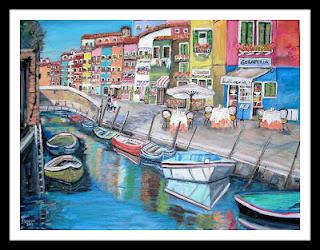 Painting by: Teresa Dominici, Acrylic on canvas, 24"x18" (60cm x 45cm), Year: 2012.
Painting by: Teresa Dominici, Acrylic on canvas, 24"x18" (60cm x 45cm), Year: 2012.
Burano is a pretty island in the northern part of Venetian lagoon. The island is located 7 Km from Venice can be reached by ferries (vaporetti) or motor-boats, it takes approximately 40 minutes. Famous for its lace making and for its brightly colored houses. Burano is a fairly small island and there is only one way to move around it, on foot. The roads here are quite narrow, in fact they are all streets and the main street here is the Calle Galuppi which is where all the shops are.
Burano, Venetian lagoon, Italy
( video 2007, Venezia, Italy). Burano is an island in the Venetian Lagoon, although like Venice itself it could more correctly be called an archipelago of islands linked by bridges. It lies near Torcello at the northern end of the Lagoon, and is known for its lacework.
Burano is situated 7 kilometers from Venice, a short 40 minute trip by Venetian motorboats, "vaporetti". The island is linked to Mazzorbo by a bridge. The current population of Burano is about 4,000. The island was probably settled by the Romans, and in the 6th century was occupied by people from Altino, who named it for one of the gates of their former city. Two stories are attributed to how the city obtained its name. One is that it was initially founded by the Buriana family, and another is that the first settlers of Burano came from the small island of Buranello, five miles to the south.
Although the island soon became a thriving settlement, it was administered from Torcello and had none of the privileges of that island or of Murano. It rose in importance only in the 16th century, when women on the island began making lace with needles. The lace was soon exported across Europe, but decline began in the 18th century and the industry did not revive until 1872, when a school of lace-making was opened. Lace-making on the island boomed again, but few now make lace in the traditional manner as it is extremely time-consuming and therefore expensive.
 Painting by: Teresa Dominici, Acrylic on canvas, 24"x18" (60cm x 45cm), Year: 2012.
Painting by: Teresa Dominici, Acrylic on canvas, 24"x18" (60cm x 45cm), Year: 2012.
